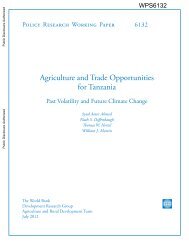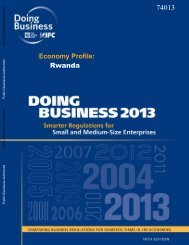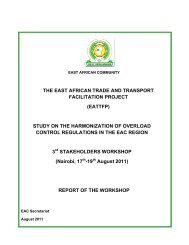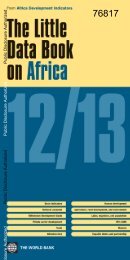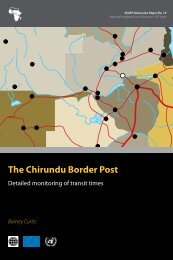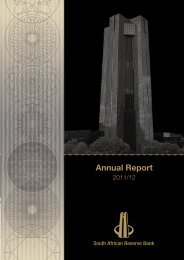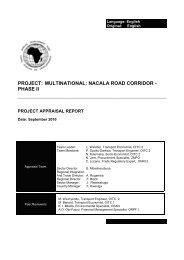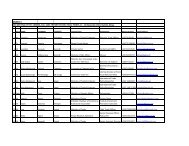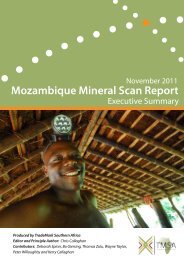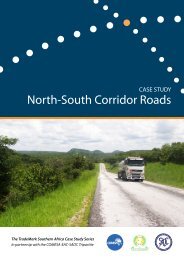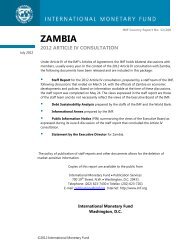Plant Health, Climate Change and Trade - TradeMark Southern Africa
Plant Health, Climate Change and Trade - TradeMark Southern Africa
Plant Health, Climate Change and Trade - TradeMark Southern Africa
Create successful ePaper yourself
Turn your PDF publications into a flip-book with our unique Google optimized e-Paper software.
4 <br />
create wounds on which aflatoxin-producing fungi proliferate. According to the FAO, 25<br />
percent of world food crops are affected with aflatoxin <strong>and</strong> countries situated within 40<br />
degrees latitude of the equator are most at risk. Aflatoxin contamination is widespread <strong>and</strong><br />
often acute in Sub-Saharan <strong>Africa</strong> where maize production is significant as livestock feed<br />
<strong>and</strong> as a staple food that accounts for 42 percent of all cereal crops in the region.<br />
Groundnuts is an important cash crop in the region that are largely controlled by women.<br />
Because of food safety regulations that aim to reduce human exposure to aflatoxins, crop<br />
contamination cause significant economic losses along the supply chain. A World Bank<br />
study estimates an annual loss of US$670 million to <strong>Africa</strong>n food exporters from attempting<br />
to meet the EU health regulation on aflatoxin.<br />
In April 2004, rural Kenya experienced one of the world's largest documented aflatoxicosis<br />
outbreaks resulting in 317 cases <strong>and</strong> 125 deaths. The source of the outbreak was linked to<br />
home grown maize harvested in February during unseasonably early rains <strong>and</strong> stored under<br />
wet conditions conducive to fungal growth. Contaminated maize entered the market<br />
distribution system when local farmers sold a portion of their household stores to market<br />
vendors. Market maize was found to be a significant source of continued exposure to<br />
aflatoxin long after contaminated household stores were consumed or discarded. This<br />
means that the potential role of the market system in sustaining exposure must be<br />
considered when public health assessments on aflatoxin outbreaks are done. The outbreak<br />
in Kenya occurred during a time of regional <strong>and</strong> national food shortages due to prolonged<br />
drought <strong>and</strong> crop failure. Immediate response efforts mainly focused on food replacement<br />
<strong>and</strong> relief whilst the need for a comprehensive food safety programme was realised.<br />
Several research studies <strong>and</strong> projects have since been done, or are in progress, to test preharvest<br />
<strong>and</strong> post-harvest technologies <strong>and</strong> good agricultural practices that may reduce the<br />
aflatoxin risk in <strong>Africa</strong>n agriculture. The International Food Policy Research Institute (IFPRI)<br />
is leading a project that was initiated in 2009, to analyze the impact <strong>and</strong> possible control<br />
measures of aflatoxin contamination on the livelihoods <strong>and</strong> health of people in Kenya <strong>and</strong><br />
Mali. This project has been launched in conjunction with the International Maize <strong>and</strong> Wheat<br />
Improvement Center (CIMMYT), International Crop Research Institute for the Semi-Arid<br />
Tropics (ICRISAT), University of Pittsburgh, Uniformed Services University of the <strong>Health</strong><br />
Sciences, Kenya Agricultural Research Institute, Institut d’Economie Rurale (Mali),<br />
ACDI/VOCA, <strong>and</strong> the East <strong>Africa</strong>n Grains Council. Research to date shows that a variety of<br />
field management practices, chemical control, biological control, postharvest practices <strong>and</strong><br />
timely harvesting may reduce aflatoxin development <strong>and</strong>/or contamination. However,<br />
efficient monitoring <strong>and</strong> surveillance with cost-effective sampling <strong>and</strong> analytical methods is<br />
needed in the region. COMESA is involved in the development of a Partnership for Aflatoxin<br />
Control in <strong>Africa</strong> (PACA) that will aim to support the implementation of cost-effective aflatoxin<br />
management programs <strong>and</strong> technologies, focusing on entire value chains to ensure a holistic <strong>and</strong><br />
integrated approach for aflatoxin control. Better underst<strong>and</strong>ing of the potential impact of<br />
climate change will allow development of improved management procedures, better<br />
allocation of monitoring efforts, <strong>and</strong> adjustment of agronomic practices in anticipation of<br />
global climate change to reduce the risk of aflatoxin contamination. Public education <strong>and</strong><br />
awareness is considered to play an important role to sensitize the population on aflatoxin<br />
risk <strong>and</strong> its management.<br />
COP 17 -‐ <strong>Trade</strong>mark <strong>Climate</strong> change impact on phytosanitary risks





